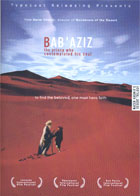
Bab’Aziz (The Prince Who Contemplated His Soul) 2005
Distributed by Typecast Releasing, 3131 Western Ave., Suite 514, Seattle, WA 09121; 206-322-0882
Producer n/a
Directed by Nacer Khemir
DVD, color, 96 min.
Jr. High - Adult
Gender Studies, Middle Eastern Studies, Storytelling
Date Entered: 05/15/2009
Reviewed by Monique Threatt, Indiana University, Herman B Wells Library, Bloomington, INBab’Aziz is the final feature film in Tunisian director Nacer Khemir’s highly praised Desert Trilogy. Each film in the trilogy takes the audience on an emotional roller-coaster ride, at first slowly building a sense of wonderment with overwhelming aesthetic and passionate discoveries, then suspending the viewer in the air for one brief intoxicating moment before the story plunges you back to earth with tales of tragedy and betrayal. At the heart of the trilogy are recurring themes of magnificent beauty, love, storytelling, and nomadic wandering. Khemir’s films are meant to invoke dialogue, to be multilayered, complex, full of abstract symbolisms, and faith.
Bab’Aziz chronicles the journey of a grandfather (Parviz Shahinkhou) and his granddaughter, Ishtar (Maryam Hamid), as they trek across the Arabian Desert in search of a dervish gathering which is held every 30 years. With no clear road, path, or compass, Bab’Aziz uses his nomadic dervish instincts to guide them in the right direction. A dervish is a person who chooses to enter a world of poverty and love, and who abandons society to wander the desert. To keep his granddaughter entertained, Bab’Aziz passes along oral stories from generations past. Most compelling is a story about a handsome Prince who is intrigued by the image of a lone gazelle in the desert. The Prince jumps on his beautifully plumed horse and gives chase. However, the gazelle is more agile and faster than the horse, and soon leads the Prince further into the desert. Miraculously, the horse finds its way back to the palace sans its Master. After a short time, a wandering dervish finds the despairing Prince in the desert, transfixed on his reflection in a pool of water. The Prince wishes to be left alone with his reflections. After many moons of contemplating his reflection, the Prince realizes his true nature and adopts the life of a dervish.
The story of the Prince is just one of many tales told in the desert. Other dervishes share stories and memories of love found and lost such as one wanderer who lost both his clothes and love to a beautiful woman. The woman steals his clothes so that she may disguise herself as a man and be able to cross borders in search of her father. Another interesting story focuses on a red-headed dervish who dives into the pit of a well in search of a long-ago palace, and, again, the most beautiful woman he has ever known. All of these stories are memories to be savored and passed along from one generation to the next. There is no permanent residency in the desert. There are no permanent paths, or roads in the desert. There are no permanent generations in the desert. Each person sets out to wander and it matters little where the path leads. However, to a dervish, the desert offers a sense of peace, tranquility, and belonging to the earth.
Like all of Khemir’s films, tragic endings are the norm. The grandfather gracefully prepares for his death in the desert before he is able to reach the music-filled celebration. In his last moments on earth, a lone gazelle peacefully waits and witnesses Bab’Aziz’s death. This reviewer is just overwhelmed at this point. The symbolism and beauty is too much to contain!
Interpreting the different metaphors and symbolism associated with Sufism, Arabic, and Muslim culture can drive the average viewer a little bit batty, but in a fantastic way. Many of the scenes are dream-like sequences, and the viewer must separate what is real and what is fantasy. Recurring images such as a lone gazelle in the middle of the desert, or a lone elaborately-decorated horse are but two metaphors symbolizing the working and ruling classes. The beauty and richness of the desert is the work of cinematographer Mahmoud Kalari. Armand Amar’s musical direction is par excellence. Khemir is without a doubt one of the most understated and gifted filmmakers of the 21st century. He shakes his audience up, while still taking them on a carpet ride to a world of magic and myth.
The other two films in Khemir’s trilogy are Wanderer’s of the Desert, and The Dove’s Lost Necklace. The film is in Arabic w/English subtitles. Highly recommended for all libraries.
Awards
- Best Film Fajr Film Festival
- Best Picture Muscat Film Festival